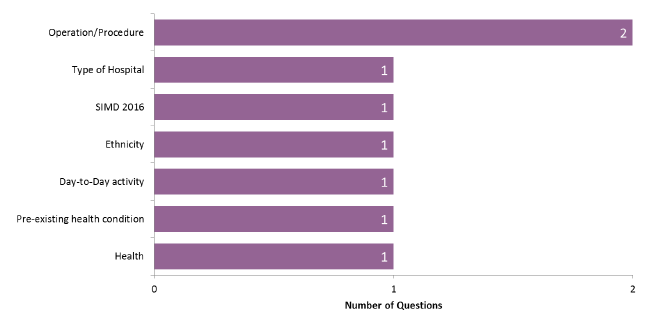Inpatient experience survey 2016, volume 3: exploring differences in experience
This report explores the differences in self-reported experience of people who responded to the inpatient experience survey 2016.
This document is part of a collection
Results - Admission To Hospital
Summary
The survey results show that 82 per cent of people were positive about their overall admission to hospital and 88 per cent were positive about the overall care and treatment they had received in A&E.
All the characteristics investigated except religion, indicated a significant impact on the differences seen in responses relating to people's experience in A&E with older people and males tending to be more positive.
People who attended hospital as a planned admission were significantly more positive regarding the overall admission experience.
People who had an operation whilst in hospital were significantly more positive regarding their overall care and treatment in A&E and any information received prior to attending hospital but were significantly more negative regarding the length of time between being referred and being admitted to hospital.
A&E
Seven of the survey questions relate to people's experience in A&E. Differences in responses for experience are significant by age, self-reported general health and gender for almost all of these questions. Religion is the only characteristic investigated which does not show any difference in experience in A&E (Figure 2).
Figure 2: Number of questions affected by various characteristics - A&E

All characteristics related to these questions are detailed in Table 2. In general, males were significantly more positive in their experiences than females, as were people who self-reported that their health was good compared to poor or fair. A mixed picture is seen for the age variable with people aged over 45, in general, being significantly more positive than younger people.
Table 2: Significant response compared to reference group - A&E
| Question |
Positive |
Negative |
|---|---|---|
| Kept informed about how long to wait to be seen |
Emergency admission; |
Age 25-34; |
| Once seen, kept informed about what was happening |
Age 35-75+; |
Poor health; |
| Told how long there would be to wait |
Age 45-74; |
Fair and poor health; |
| Told what was happening in a way you could understand |
Had an operation; |
Fair and poor health; |
| Given enough privacy when being examined or treated |
Age 45-75+; |
Fair and poor health; |
| Felt safe |
Age 65-75+; |
Long term health condition; |
| Overall rating the care and treatment received |
Had an operation; |
Poor health; |
The question relating to being kept informed on the wait to be seen in A&E indicated that those aged between 25-34 years old were significantly more negative than those aged 16-24 years old, whereas those aged over 55 were significantly more likely to report a positive experience.
People reporting fair or poor health or a pre-existing health condition are significantly more negative than those in good health or with no pre-existing condition. This is also seen with people who find that day-to-day activities are limited due to health.
Planned in advance
Two questions in the survey ask about people's experience of planned hospital admissions and seven characteristics are associated with the variation seen. Age and gender are not found to explain for any variation seen for these questions (Figure 3).
Whether a person had an operation or procedure did show variations for both questions in this section of the survey.
Figure 3: Number of questions affected by various characteristics - planned admission

All characteristics related to these questions are detailed in Table 3.
People who reported having an operation were significantly more positive about the information they had received before attending hospital but were significantly more negative regarding the length of time between waiting to be admitted to hospital after being referred.
Table 3: Significant response compared to reference group - planned admissions
| Question |
Positive |
Negative |
|---|---|---|
| Length of time you waited to be admitted to hospital after being referred |
SIMD 3; |
Had an operation; |
| Information given before attending hospital helped understand what would happen |
Had an operation |
Fair health; |
Overall rating of admission to hospital
Two questions in the survey ask about people's overall experience of admission regardless of whether it was planned or an emergency. Ethnicity and whether an interpreter or help to communicate are needed, did not account for any variation seen for these questions (Figure 4).
Figure 4: Number of questions affected by various characteristics - overall admission

All characteristics related to these questions are detailed in Table 4.
As with other questions, age and gender are associated with some of the differences seen in experience, with people aged over 45 and males being significantly more likely to report a positive experience. The type of hospital where people were treated also showing differences, with those staying in community, long stay and general hospitals being significantly more positive compared to those treated in teaching hospitals.
People who were admitted to hospital as an emergency admission were significantly more negative compared to those who had a planned admission to hospital, as were those describing their general health as poor.
Table 4: Significant response compared to reference group - all admissions
| Question |
Positive |
Negative |
|---|---|---|
| How did you feel about the time you had to wait to get a bed on the ward |
Had an operation; |
Emergency and something else admissions; |
| Overall, how would you rate your admission to hospital |
Had an operation; |
Emergency and something else admissions; |
Contact
Email: Nicola Kerr
There is a problem
Thanks for your feedback